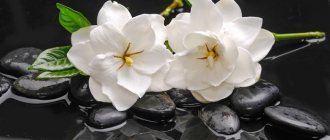Cyclamen refers to tuberous herbaceous plants that hibernate under unfavorable conditions.
Inexperienced gardeners perceive the withering of leaves as death and throw out the “dormant” plant. Origin. In the wild it grows in the southern regions of Europe, the Mediterranean and Asia Minor. Prefers foothill areas and regions with a mild climate, where winter temperatures do not fall below 10 degrees. It belongs to the family of primroses (lat. Primulaceae), to the subfamily myrsinaceae (lat. Myrsinaceae).
Size. The height of cyclamen does not exceed 30 cm , young flowering plants are from 10 cm. The size of leaves, flowers and the volume of the bush depends on the age and variety.
Lifespan and growth. The cyclamen bulb is a long-lived bulb and grows up to 30 years. The older the plant, the more magnificent the crown, but the size of the flowers becomes smaller and their number increases.
With the onset of winter, the plant becomes a popular gift. It is during the cold season that it pleases flower growers with its lush flowering. The unusual leaves and flowers of this plant delight lovers of flowering beauties.
Don't forget to check out the equally beautiful Gloriosa plant.
| Average growth rate. |
| Blooms from November to March. |
| The plant is suitable for an experienced grower. |
| Perennial. |
Signs and superstitions
On the esoteric side, cyclamen has a good effect on family relationships. Disagreements in the family between generations will disappear and peace and understanding will reign in the house.
- It has a beneficial effect on the person caring for cyclamen. It allows you to get rid of sudden mood swings and normalize sleep.
- By placing the plant in the bedroom, the couple will strengthen their bonds and be able to have a child.
- The aura of the plant protects from the influence of evil people and their envy.
- People living in a house where there is cyclamen gradually experience good luck and inspiration, a desire for new achievements and self-development.
- For people suffering from mental disorders, stress, despondency and anxiety, the plant gives peace and good sleep.
Features of home care
| Temperature | In winter they are kept at temperatures from 12 to 16 ⁰С, and in summer up to 24⁰С. |
| Air humidity | At home, you need to spray and maintain high humidity (up to 50%). |
| Lighting | Bright diffused light. The ideal location is western and eastern windows. |
| Watering | Moderate, up to 3 times a week through the tray. Overmoistening and drying out of the soil is not allowed. During the dormant period, watering is reduced to once a week. |
| Priming | The plant requires slightly acidic soil with a pH of 5.5-6.5. A ready-made substrate for Saintpaulias is suitable. When making it yourself, sand, black soil and peat are mixed in equal parts. Drainage is placed at the bottom of the pot. |
| Feeding and fertilizer | During the growing season, fertilizing is applied every 2 weeks until flowering begins. To do this, use universal fertilizers or fertilizers for flowering plants with a low nitrogen content and without chlorine. |
| Transfer | When the leaves begin to grow, they are transplanted into a low container with nutrient soil. The tuber is dug in halfway. |
| Reproduction of cyclamen | The plant is propagated by dividing the tuber, as well as by seeds. With the help of flowers, you can cross several varieties, obtaining a unique plant. When grown from seeds, it blooms in the second year of life. |
| Peculiarities | Different maintenance conditions are required during periods of dormancy, flowering and growing season. Removing faded flowers and leaves strictly involves twisting the stem from the tuber without leaving any residue. The tuber rots when water stagnates or is watered from above. |
Growing from seeds
The method is considered the most reliable, but requires experience and patience. Cyclamens grown from their own planting material will bloom in 3-4 years, some species - after 1-2 seasons.
Collecting seeds
You will have to pollinate the plant manually, transferring pollen with a soft brush or cotton swab from flower to flower. It is recommended to carry out the procedure on a sunny morning and repeat several times.
When the boxes begin to dry, put bags on them. The doors open on their own and the seeds spill out.
Sowing and care
A low, wide bowl is filled with a peat-sand mixture and compacted. Seeds are sown immediately after collection without drying. The germination rate of purchased ones is questionable. Cover with a 1 cm layer of substrate. After light pressing, it will decrease to 5 mm. Cover the container with glass or cellophane and keep it at 18-20° C.
Light is not needed for cyclamen seeds to germinate.
Air the bowl daily, and if necessary, irrigate it with soft water from a household spray bottle. After about 40 days, as soon as the shoots appear, they are transferred to a bright, cool place with a temperature of 15-17 ° C.
They dive in the phase of 2-3 true leaves. By this time, some of the sprouts will have time to form a tiny tuber.
Caring for cyclamen at home (in detail)
At home, cyclamen needs special conditions close to natural ones. Creating such conditions in an apartment is the main difficulty in breeding and maintaining these beautiful plants.
Temperature
Under natural conditions, cyclamen “wakes up” with the onset of the cold season. Favorable temperature for the start of growth is 10-15⁰С. The ideal place for a flower would be a cold window, a winter garden or an insulated balcony. The temperature during flowering should not rise above 20⁰C. Otherwise, the plant will shed all its buds and leaves and go into hibernation. Sharp temperature fluctuations and drafts are detrimental to the tuber; it rots and is affected by fungi.
With the beginning of spring, cyclamen can be placed on the balcony or outside (provided that the air temperature does not fall below 10⁰C and does not rise above 24⁰C).
Low temperatures lead to the death of the tuber.
Air humidity
The plant requires high air humidity. Spray the leaves daily, without getting water on the tuber. When buds begin to set and flowering begins, spraying is stopped. Contact with water leads to rotting.
Spray only with soft water at room temperature. Hard water forms a crust of mineral deposits that interfere with photosynthesis.
Dishes with hydrogel balls, which will gradually release moisture into the air, will help increase the humidity of the environment. Moss placed in a tray will also solve this problem.
If there is a battery, cover it with a damp cloth. This will protect the flower from heat and humidify the air well.
Lighting
Homemade cyclamen needs 10 hours of bright light without direct rays. If rays fall on the window with a flower, then it needs to be shaded.
For example, place a bush of another plant between the window and the cyclamen or cover it with a screen made from scrap materials. Western and eastern windows are ideal for plant placement. The south window can be adapted to its contents, blocking it from the sun and maintaining a favorable temperature. With a lack of light, leaves and flowers turn pale, stretch out, and growth stops.
During the dormant period, the pot with the “dormant” tuber is removed to a cool place with dense shade. For example, on the north window.
Watering
Watering is carried out only through a tray, since moisture entering the tuber leads to its diseases.
An hour after watering, the remaining water from the pan is drained. Settled water at room temperature is suitable for irrigation. In hot weather, the top layer of soil cannot be properly saturated with moisture, so experienced gardeners resort to careful watering along the edge of the pot.
Yellowed leaves often signal waterlogging of the soil. Most often, this is perceived the other way around and leads to the death of the flower.
When kept in a cool room, water once a week. When the air temperature is above 17⁰C, the dryness of the soil is monitored by assessing the weight of the pot.
In hot weather, water up to three times a week.
Bloom
Cyclamen blooms at home after a period of dormancy. Stimulates flowering by lowering the temperature to 15⁰C.
The plant, subject to proper care, blooms profusely from mid-autumn to early spring. As the temperature rises, a period of rest begins.
Rest period
After abundant flowering, the plant requires proper care and rest. A signal that a flower is ready is the yellowing of the leaves and the absence of new buds. Cuttings of wilted parts are removed without residue. If you do not remove them, but cut them off, then the remnants of the cuttings rot along with the tuber.
Watering is gradually reduced. The rest period lasts from three to five months. Its onset is stimulated by an increase in temperature.
Priming
The cyclamen flower needs water- and breathable soil. Special mixtures are suitable for cyclamens and violets. To improve looseness, calcined river sand is added.
To prepare the substrate yourself, you need to mix forest humus with peat and sand in equal proportions.
A tuberous plant requires good water drainage, so fill 1/4 of the pot with drainage. Use stones, expanded clay or coarse sand.
Feeding and fertilizer
During the period of active growth and awakening, cyclamen needs additional feeding. Chlorine-free liquid products with a low nitrogen content are suitable as fertilizers. Nitrogen provokes abundant growth of greenery, the flowers will be small and few in number.
Fertilizers are applied before flowering once every two weeks. After setting the buds, stop feeding.
Transfer
Cyclamen is replanted every two years when growth begins.
When the first leaves appear, it is pulled out of the pot and the old substrate is shaken off a little. The earthen lump around the tuber is not touched. A pot for cyclamen must comply with two rules:
- be short and not wide;
- the distance from the tuber to the edge of the pot is about 3 cm.
In large and tall containers, the flower will not be able to receive enough moisture, and in too small containers, there will not be enough space for the development of the root system.
Place drainage and a layer of prepared substrate at the bottom of the pot. The tuber with the old lump is placed in the center, the edges are covered with earth, pressing lightly. The tuber should remain 1/2 above the substrate.
After transplantation, the plant is not fertilized for a month.
The great advantage of the plant is its friendly coexistence in the same pot with its own kind. Keeping a distance of 4 cm from each other, cyclamens form a beautiful cluster of multi-colored buds in one container.
Pitfalls of purchased cyclamen
Store-bought cyclamen is handled with care. Before entering the house, the plant experienced several stresses due to transplantation and a change in the usual climate. The conditions of its maintenance in the greenhouse differ from those at home. The flower needs to be helped to get used to its new life. Replanting cyclamen after purchase is recommended after 1-2 months. Vigorous peduncles and leaves may wilt after a day in the apartment. Don't rush to water or feed them.
The plant adapts to the new temperature and humidity. Choose a cool but bright place for it. Check the degree of moisture in the earthen ball with a dry stick. If necessary, water through the drip pan. Fertilizers will not be needed for several months. The fact is that store-bought specimens are overfed for abundant flowering. Spraying water with Zircon will help the leaves recover. This is a universal growth regulator that increases disease resistance and root formation activity.
When is a transplant necessary?
Often indoor flowers are sold in transport soil, not intended for long-term use. It is poor in nutrients, but is impregnated with a large amount of fertilizers. This supports the plant for a certain time, and then it begins to turn yellow and wither. Replanting from such soil is desirable before the end of the adaptation period. It is necessary to change the soil in the following situations:
- noticed pests in the ground;
- low quality substrate;
- rotting of plant roots.
Reproduction
At home, propagating cyclamen is an activity that does not cause difficulties even for novice gardeners.
The flower can be propagated in four ways: by seeds, dividing the tuber, by children, by rosettes.
Reproduction by children
The mother tuber produces babies from time to time. Small nodules are planted in a separate container, observing the conditions of planting, watering, temperature and daylight hours. Fertilizers are applied every other week.
Propagation by tubers
The division of the tuber is carried out strictly during the dormant period. To prevent the flowers from becoming smaller, large cyclamens are cut into two halves, producing two adult plants. The tuber is dried and then cut with a stationery knife, leaving several buds on each half. The cut site is treated with charcoal and dried, and then planted in prepared pots.
Reproduction by rosettes
After the flowering period, large rosettes are planted in a container with moist soil. The temperature at which the rosette survives well does not exceed 17⁰C.
Diseases and pests
Due to the “capriciousness” of the plant, its maintenance is often accompanied by problems associated with non-compliance with care conditions.
- The leaves of the cyclamen have turned yellow. The leaves turn yellow as part of the natural process of shedding their greenery before dormancy. If the leaves begin to yellow unevenly, this may be due to direct sunlight. Rotting of the tuber is also accompanied by yellowing of the leaves. In this case, the yellowness begins from the cuttings. In any case, if the leaves turn yellow, you need to inspect the surface of the tuber. If the tuber is rotten, then the affected part is cut off and sprinkled with coal. Hard water causes the leaf to die, but the cutting remains normal.
- Leaves are falling. This phenomenon occurs in two cases: rotting of the tuber and transition to the dormant stage. It is necessary to examine and feel the tuber for softness and wateriness.
- The roots are rotting. The reason is waterlogging of the soil. Cyclamen is transplanted into new soil, completely clearing the old one.
- Slowly growing. Slow growth in cyclamen is observed in insufficient lighting and lack of nutrients in the soil.
- Doesn't bloom. If the cyclamen leaves are fine, but there are no flowers, then the pot chosen for replanting is too large. The use of nitrogen fertilizer also leads to inhibition of flowering and the formation of a large number of leaves.
- The leaves are drying. Drying of leaves, while maintaining general turgor, indicates too dry and hot air. It is necessary to increase the humidity, remove it from the heat source and avoid direct sunlight.
- Light spots appear on the leaves. Light-colored spots appear due to burns from the sun's rays, when the root system and tuber are damaged.
- Leaves curl. This is the plant's response to stress. The cause may be dirty air. Cyclamen does not tolerate smoke, car exhaust gases, or tobacco smoke. Acidic soil is also very stressful for the plant. Clay content in the soil is unacceptable. Stress occurs during active feeding during the period when the flower is trying to enter the dormant stage.
Pests
After purchasing a new plant, you need to keep it in isolation for about two weeks. The pest may not appear immediately.
- Shield. Sticky plaque and brown spots are the result of scale insects.
- Mealybug. These are gray small insects that infect the axils of leaves.
- Spider mite. It is easily recognized by the cobwebs on the leaves. The plant is affected by this insect in dry and warm air.
- Cyclamen mite. When affected, flowers and leaves grow underdeveloped and crooked. Sometimes the buds do not open and fall off. The infected plant is disposed of.
- Aphid. She drinks juice from leaves and peduncles, interfering with normal nutrition. Parts of the plant grow poorly. Aphids form clusters and are easy to spot on cuttings.
Procedures after purchase
After acquiring cyclomenia:
- You need to carefully examine the plant again. If damaged leaves and flowers are identified, remove them.
- The plant is kept in quarantine for some time and treated for preventive purposes.
- All plants purchased in the store require careful care and replanting.
After purchasing a cyclomenia flower, you need to inspect the root system. Replace the substrate, since the transport soil in which the plant arrives at the store is filled with a large amount of fertilizer to maintain it in marketable condition. Often the substrate contains larvae of various pests. When replanting a plant into new soil, you should carefully remove the old one and wash the roots. Often the transplanted plant withers and dies. This occurs after intensive feeding of cyclamen with stimulants, and the plant becomes dependent on them. Therefore, experts give the following advice on care after purchasing and replanting a cyclomenia flower:
- fertilize more often, gradually reducing the dose of fertilizer;
- if rotten areas on a tuber are identified, they must be removed and the cut areas sprinkled with activated carbon;
- The entire tuber should not be buried in the ground; the upper part should stick out of the pot;
- pre-steam or calcinate the purchased soil.
Types of homemade cyclamen with photos and names
There are two types of domestic cyclamen: Persian and European. They vary in care and life cycle.
Cyclamen persica
Its second name is alpine violet. It has a large flattened tuber. The leaves are gray-green to dark green with a bluish pattern. Varieties have different flower colors: white, red, pink and all shades of purple. The size of the flowers depends on the variety. Small-flowered varieties have a delicate aroma and are better adapted to apartment conditions.
Popular varieties:
- Cardinal . It has bright large scarlet flowers. The growth of the bush reaches 30 cm.
- Kaori . A dwarf variety with small flowers with a pleasant scent. The stigma of the bud has a contrasting color.
- Rex . Average size of flowers and bush. The leaves are decorated with a silver pattern.
- Decor . Beautiful color of buds. There are salmon, purple and pink flowers. Leaves with marble patterns.
European cyclamen
A distinctive feature of this species is its life cycle. It has no dormant period and has leaves all year round. It has smaller flowers and leaves than the Persian variety.
The most common colors of flowers are shades of pink and purple. Most suitable for growing at home. Feels comfortable at temperatures up to 20⁰C and low humidity.
Description of the plant
The flower is one of the representatives of the Myrsinaceae family. Although some scientists classify it as a Primrose. Cyclamen is represented by corms with ovoid-shaped basal leaf plates. The color is dark green. Leaves develop on long petioles (about 30 cm). Their decorative effect is enhanced by the pattern of silver weaves. The inflorescences are also original. They are pointed and curved back, the edges of the petals are framed with fringe.
Beneficial features
In addition to decorative qualities, the culture also has medicinal qualities. The juice of cyclamen flower tubers has anti-inflammatory and antimicrobial properties. This makes it possible to use it for sinusitis, frontal sinusitis, sinusitis and other diseases of the nasopharynx. In alternative medicine, the juice, which contains alkaloids, has found use in the preparation of rubs. The latter help relieve pain from rheumatism and gout. Cyclamen-based products help fight cardiovascular disorders.
Species diversity
In the natural environment, cyclamen is represented by 20 species. However, only a few are common in culture. Popular:
- European cyclamen, also known as alpine violet, is a typical species with medium-sized leaves and blooms with fragrant pink-lilac inflorescences. Based on it, breeders have developed varieties with a white, carmine color. Of all the species, alpine violet is the most tolerant of indoor conditions.
- Persian has been a cultivated species since 1731. It is valued for the originality of its inflorescences, which, when in bloom, seem to turn inside out and grow with their petals facing downwards.
- Pontine is an evergreen flowering plant. Its peculiarity is the flowers on “bare” arrows rising high above the foliage.
- African - the species blooms very profusely. It has the largest tuber among other representatives - up to 14 cm in diameter.
Cyclamen flowering
The timing of the onset of the phase is influenced by the variety, as well as growing conditions. Flowering often occurs in the second half of autumn. If the required microclimate is created for the flower, flowering continues for 2-3 months. The color range of inflorescences is very wide. There are varieties with snow-white flowers, scarlet, burgundy and even purple, and all sorts of shades of pink.
Please note! Cyclomenia is a poisonous plant. If children live in the apartment, it is better to refuse it.











